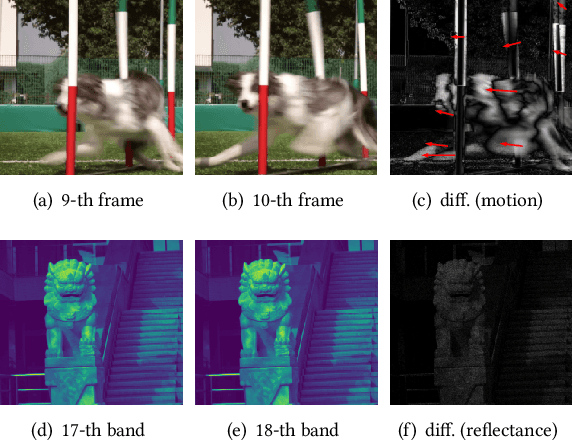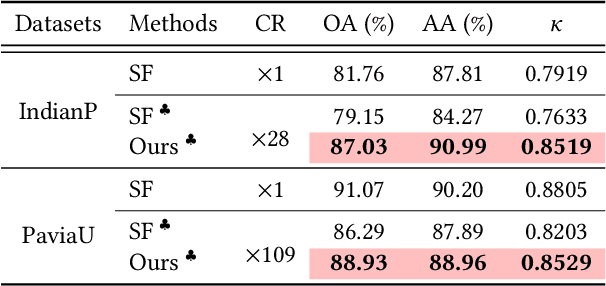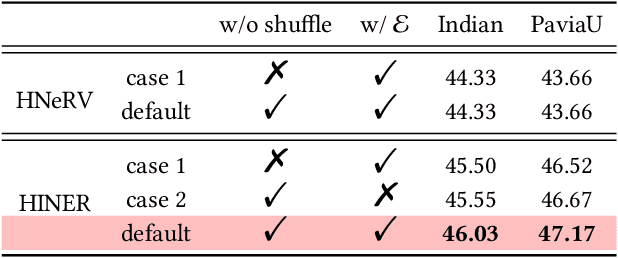Junqi Shi
On Quantizing Neural Representation for Variable-Rate Video Coding
Feb 17, 2025Abstract:This work introduces NeuroQuant, a novel post-training quantization (PTQ) approach tailored to non-generalized Implicit Neural Representations for variable-rate Video Coding (INR-VC). Unlike existing methods that require extensive weight retraining for each target bitrate, we hypothesize that variable-rate coding can be achieved by adjusting quantization parameters (QPs) of pre-trained weights. Our study reveals that traditional quantization methods, which assume inter-layer independence, are ineffective for non-generalized INR-VC models due to significant dependencies across layers. To address this, we redefine variable-rate INR-VC as a mixed-precision quantization problem and establish a theoretical framework for sensitivity criteria aimed at simplified, fine-grained rate control. Additionally, we propose network-wise calibration and channel-wise quantization strategies to minimize quantization-induced errors, arriving at a unified formula for representation-oriented PTQ calibration. Our experimental evaluations demonstrate that NeuroQuant significantly outperforms existing techniques in varying bitwidth quantization and compression efficiency, accelerating encoding by up to eight times and enabling quantization down to INT2 with minimal reconstruction loss. This work introduces variable-rate INR-VC for the first time and lays a theoretical foundation for future research in rate-distortion optimization, advancing the field of video coding technology. The materials will be available at https://github.com/Eric-qi/NeuroQuant.
HINER: Neural Representation for Hyperspectral Image
Jul 31, 2024



Abstract:This paper introduces {HINER}, a novel neural representation for compressing HSI and ensuring high-quality downstream tasks on compressed HSI. HINER fully exploits inter-spectral correlations by explicitly encoding of spectral wavelengths and achieves a compact representation of the input HSI sample through joint optimization with a learnable decoder. By additionally incorporating the Content Angle Mapper with the L1 loss, we can supervise the global and local information within each spectral band, thereby enhancing the overall reconstruction quality. For downstream classification on compressed HSI, we theoretically demonstrate the task accuracy is not only related to the classification loss but also to the reconstruction fidelity through a first-order expansion of the accuracy degradation, and accordingly adapt the reconstruction by introducing Adaptive Spectral Weighting. Owing to the monotonic mapping of HINER between wavelengths and spectral bands, we propose Implicit Spectral Interpolation for data augmentation by adding random variables to input wavelengths during classification model training. Experimental results on various HSI datasets demonstrate the superior compression performance of our HINER compared to the existing learned methods and also the traditional codecs. Our model is lightweight and computationally efficient, which maintains high accuracy for downstream classification task even on decoded HSIs at high compression ratios. Our materials will be released at https://github.com/Eric-qi/HINER.
Rate-Distortion Optimized Post-Training Quantization for Learned Image Compression
Nov 05, 2022Abstract:Quantizing floating-point neural network to its fixed-point representation is crucial for Learned Image Compression (LIC) because it ensures the decoding consistency for interoperability and reduces space-time complexity for implementation. Existing solutions often have to retrain the network for model quantization which is time consuming and impractical. This work suggests the use of Post-Training Quantization (PTQ) to directly process pretrained, off-the-shelf LIC models. We theoretically prove that minimizing the mean squared error (MSE) in PTQ is sub-optimal for compression task and thus develop a novel Rate-Distortion (R-D) Optimized PTQ (RDO-PTQ) to best retain the compression performance. Such RDO-PTQ just needs to compress few images (e.g., 10) to optimize the transformation of weight, bias, and activation of underlying LIC model from its native 32-bit floating-point (FP32) format to 8-bit fixed-point (INT8) precision for fixed-point inference onwards. Experiments reveal outstanding efficiency of the proposed method on different LICs, showing the closest coding performance to their floating-point counterparts. And, our method is a lightweight and plug-and-play approach without any need of model retraining which is attractive to practitioners.
 Add to Chrome
Add to Chrome Add to Firefox
Add to Firefox Add to Edge
Add to Edge